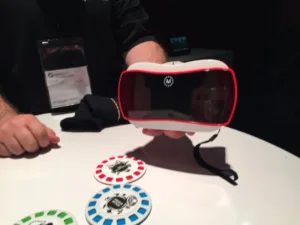Mattel’s new version of Viewmaster will crack open to allow a smart phone to be put inside and viewed in stereo 3D with a unique twist, support for Vuforia object recognition, triggering events by simply pointing to the circular cards shownQualcomm’s Connected Experiences group was also at Siggraph, with a booth showing off a new set of Mattel VR glasses, to be launched in October under the Viewmaster brand (Mattel Builds on Cardboard to Return Viewmaster). Yes – this echoes the old 3D glasses with the circular film card most of us played with as kids, but this updated next-millennium version uses a smartphone to power its dual view device. Qualcomm’s David Beard said it’s really a “Mixed Reality VR + AR” product, which transitions information from the real world. The device uses objects (an update of one of those circular film cards with the image of a dinosaur) in the real world and – with the help of shape recognition – triggers a VR experience on the display in stereo 3D. Beard told us Qualcomm is helping Mattel enable the head-up technology, and is reaching out to application content providers for next generation images and detailed story-based content for the new system.
The work is an extension of the Qualcomm VuForia mobile vision platform (Qualcomm Sets Out Vuforia Use), including an SDK that helps developers create a unique object ‘vision’ experience for smartphones, tablets and digital eyewear. In short, “Vision based AR,” according to Liat Ben-Zur at Qualcomm’s Ecosystem team, “…takes in the user’s [real] environment via a live camera stream and processes it in real time, enabling graphics to appear anchored to that environment,” she said in the Qualcomm Developer Network Blog.
The Vuforia platform makes use of computer vision (usually the smartphone camera) that allows apps to “see” objects the group calls “targets.” These include target classes like objects (think cylinders, text and boxes for example), images (identifying magazine covers faces or other details), user defined images (personal photos, faces, pets etc) and frame markers (similar to QR codes with unique images added). The diverse technology can be used in many ways, from desktop apps to mobile nomadic devices.
The software will reconstruct 3D terrain in real time, and offers extended tracking that follows objects even when moved out of the initial view for large area game play. The toolset even includes occlusion management for partially-hidden objects, just like physical objects in real space. The platform supports Eclipse, Xcode and Unity software engines, an API in C++, Java Objective-C and .Net languages, so the SDK supports both Apple iOS- and Android-based systems. It enables the development of a single native app that can reach cross platform and well into the VR/AR domain.
Qualcomm Connected Experiences Inc. was founded in 2005 and offers software platforms that empower next generation devices. Beyond Vuforia (that targets VR and AR) the group also offers AllPlay SDK for gaming development.

